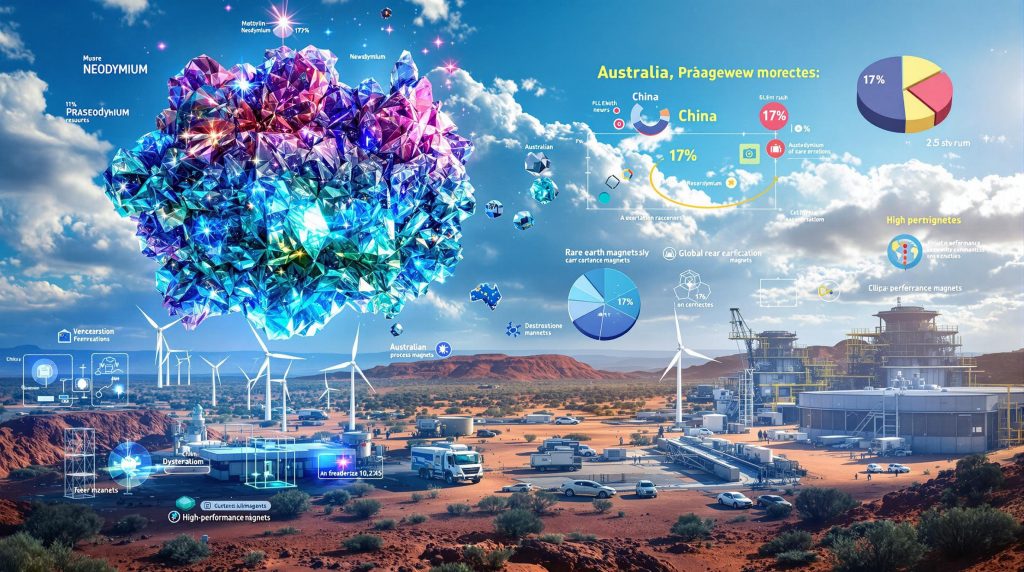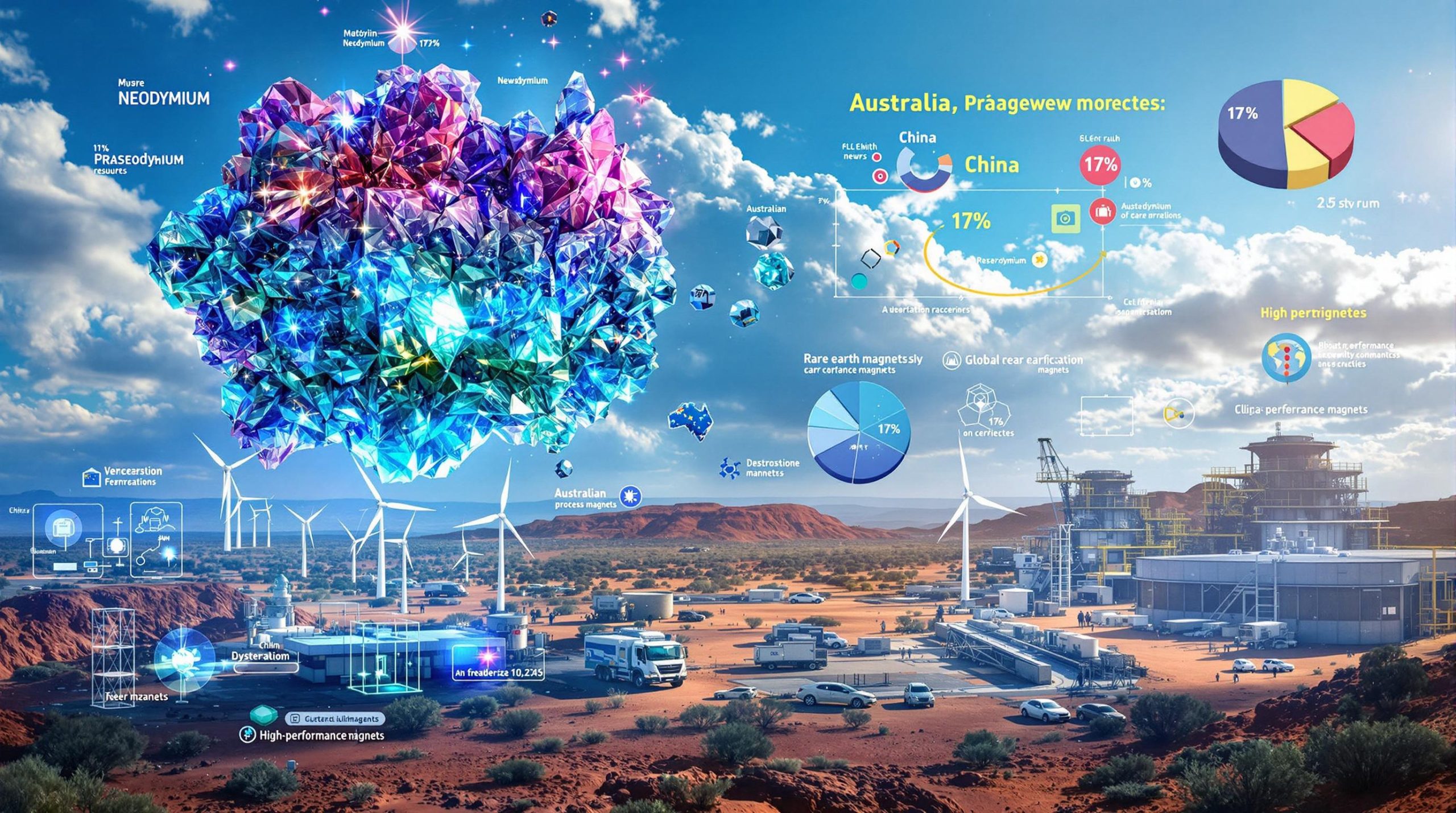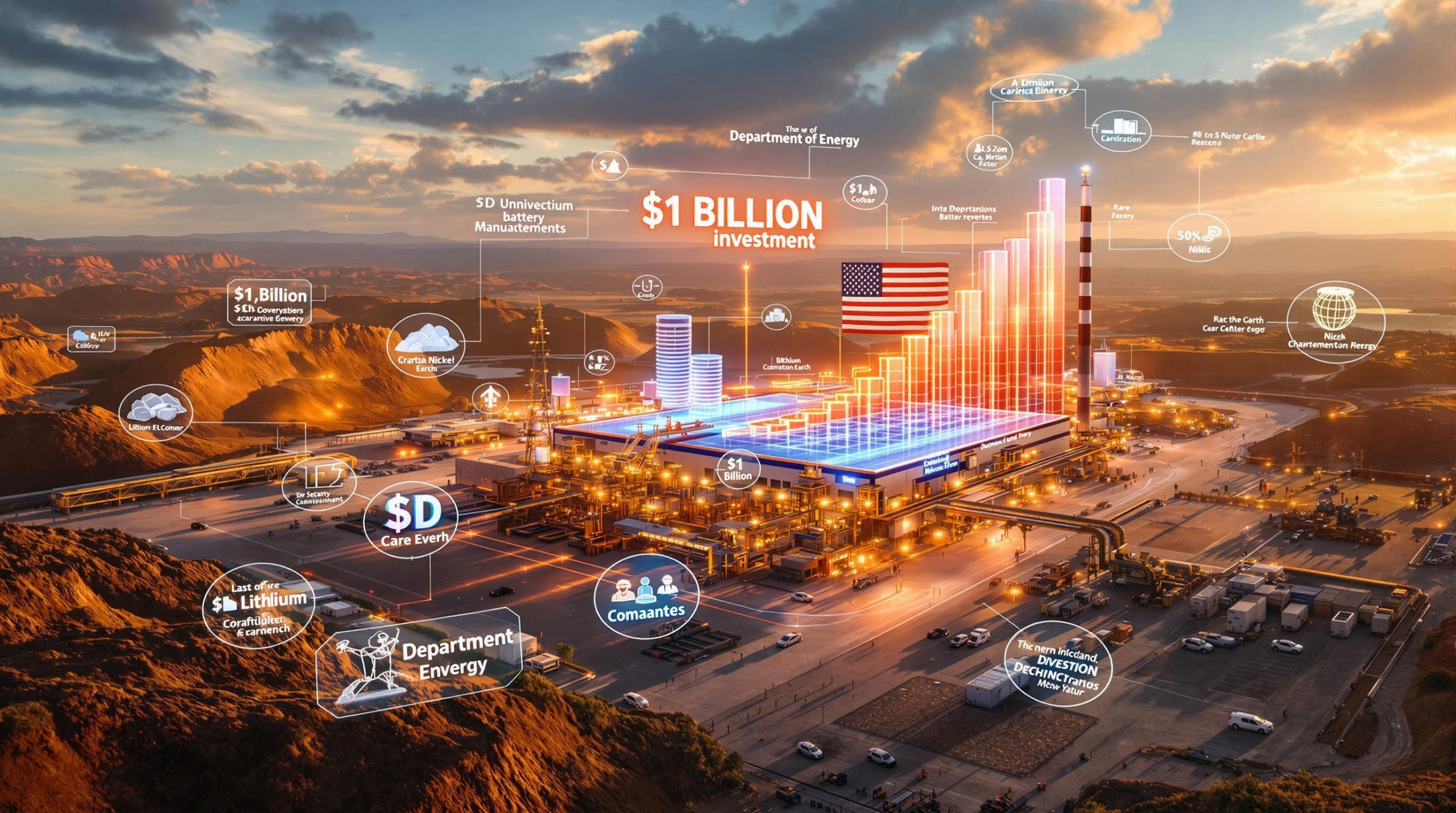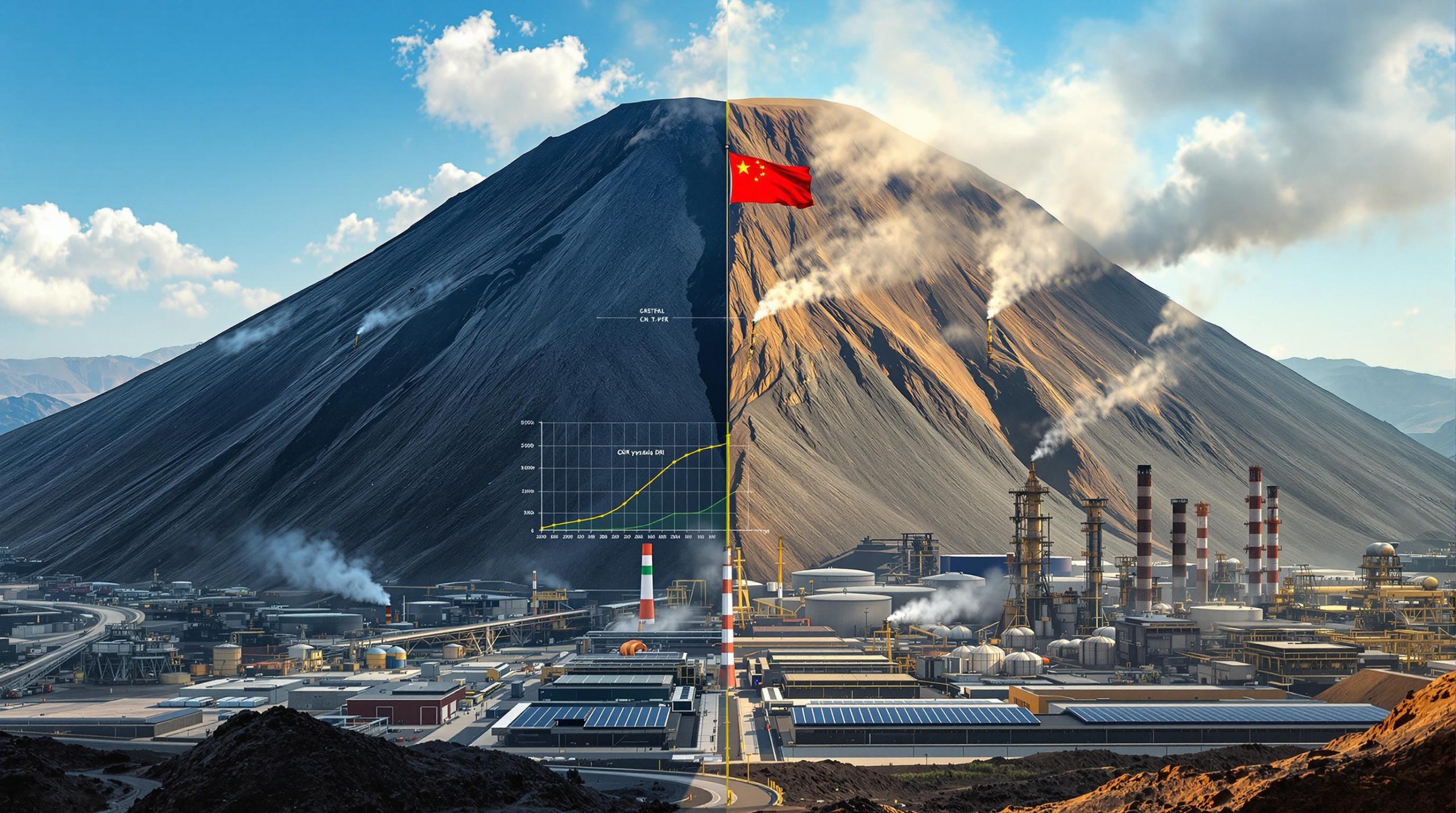Australia's Strategic Position in the Global Rare Earth Mining Landscape
Australia is rapidly establishing itself as a crucial player in the global rare earth elements (REEs) market. With growing concerns about China's market dominance, Australia's rich deposits, stable regulatory environment, and commitment to sustainable mining practices position it as an increasingly important alternative source of these critical minerals energy transition.
According to recent industry assessments, Australia has been steadily increasing its market share, with projections suggesting it could supply up to 20-25% of global rare earth production by 2030, up from approximately 10% today.
The country's strategic approach combines expanded mining operations, development of domestic processing capabilities, and international partnerships to strengthen its position in this strategically vital sector.
What Makes Rare Earth Elements Strategically Important?
Critical Applications Driving Global Demand
Rare earth elements represent a group of 17 metallic elements that are indispensable to modern technology. Despite their name, most REEs are relatively abundant in the Earth's crust, but rarely found in concentrated, economically viable deposits.
These elements are essential for:
- High-performance permanent magnets used in electric vehicles and wind turbines
- Precision optics and lasers for medical and defense applications
- Catalytic converters and petroleum refining
- Phosphors for displays and lighting
- Polishing compounds for electronic components
The International Energy Agency estimates that demand for REEs could increase by 300-700% by 2040, driven primarily by clean energy technologies.
Geopolitical Significance in Modern Supply Chains
The concentration of rare earth mining and processing capabilities has created significant geopolitical concerns. China's historical dominance—controlling approximately 70% of global production and 90% of processing capacity—has raised supply security issues for Western nations.
Following China's temporary export restrictions in 2010, rare earths became recognized as strategically critical minerals by the United States, European Union, Japan, and Australia.
"Rare earths represent the most significant supply chain vulnerability for many advanced economies. Their concentration in a single nation's control has elevated these minerals from obscure elements to centerpieces of national security strategies." — Australian Strategic Policy Institute, 2022
This vulnerability has prompted many nations to develop domestic sources and processing capabilities, with Australia emerging as a key partner in efforts to diversify global supply chains.
Australia's Rare Earth Resources
Major Deposits and Mining Operations
Australia possesses world-class rare earth deposits across multiple states and territories. The country's geological diversity provides access to both light and heavy rare earth elements.
Key Australian rare earth projects include:
| Project | Location | Developer | Primary REEs | Status |
|---|---|---|---|---|
| Mount Weld | Western Australia | Lynas Rare Earths | Light REEs (Nd, Pr) | Operating |
| Browns Range | Western Australia | Northern Minerals | Heavy REEs (Dy, Tb) | Pilot plant operational |
| Nolans | Northern Territory | Arafura Resources | Light REEs (Nd, Pr) | Advanced development |
| Yangibana | Western Australia | Hastings Technology Metals | Light REEs (Nd, Pr) | Construction phase |
| Dubbo | New South Wales | Australian Strategic Materials | Heavy REEs, Zr, Hf, Nb | Advanced development |
Mount Weld stands out as one of the world's highest-grade rare earth deposits, with ore grades significantly higher than many international competitors.
Comparative Advantage in Global Context
Australia holds approximately 3.4 million tonnes of rare earth oxide reserves, representing about 17% of known global resources. This places Australia second only to China in terms of resource endowment.
Australian deposits offer several advantages:
- High concentrations of magnet rare earths (neodymium, praseodymium, dysprosium)
- Lower levels of radioactive elements compared to some international deposits
- Stable jurisdiction with established mining infrastructure
- Proximity to key Asian markets
Recent geological surveys suggest that Australia's actual rare earth potential may be significantly larger, with unexplored regions in Western Australia, the Northern Territory, and South Australia showing promising indicators.
Developing Australia's Rare Earth Processing Capabilities
Current Processing Infrastructure
Processing has historically been the missing link in Australia in rare earth mining supply chain. While mining capabilities existed, most Australian rare earth concentrate was previously shipped overseas for separation and refining.
This landscape is changing rapidly with significant investments in domestic processing:
Lynas Rare Earths operates the most advanced rare earth processing facilities in Australia, including:
- Concentration plant at Mount Weld, Western Australia
- Rare earth processing facility in Kalgoorlie, Western Australia
- Advanced Materials Plant in Kwinana (under development)
These facilities represent critical steps in establishing a complete Australian supply chain from mine to magnet manufacturing.
Challenges in Establishing Complete Supply Chains
Despite progress, Australia faces significant hurdles in developing full rare earth processing capabilities:
-
Capital Intensity: Building separation facilities requires investments of hundreds of millions of dollars, with long payback periods.
-
Technical Complexity: Separating individual rare earth elements involves hundreds of extraction stages due to their similar chemical properties.
-
Energy Requirements: Processing facilities require substantial energy inputs, creating challenges in balancing costs and environmental impacts.
-
Competition: Chinese processors benefit from economies of scale, government subsidies, and less stringent environmental regulations.
"The processing challenge represents the most significant barrier to establishing secure rare earth supply chains outside China. Investing in these capabilities requires patient capital and strategic vision beyond typical mining timeframes." — Resources Technology Symposium, Perth, 2023
Government Initiatives Supporting Australia's Rare Earth Sector
Policy Framework and Financial Support
The Australian government has implemented a multi-faceted approach to developing the rare earth sector:
-
Critical Minerals Strategy: A comprehensive framework prioritizing rare earth development through regulatory support and research funding.
-
Financial Backing: The government has allocated over $2 billion through various mechanisms to support Australia's strategic reserve of critical minerals projects, including:
- Export Finance Australia funding for critical minerals developments
- Modern Manufacturing Initiative grants for value-adding capabilities
- Critical Minerals Facility providing loans for strategic projects
-
Research Support: Funding for the CSIRO and university partnerships focused on improving processing efficiency and environmental performance.
International Partnerships and Agreements
Australia has pursued strategic international alliances to strengthen its position:
-
U.S.-Australia Critical Minerals Partnership: Formal cooperation agreement to develop rare earth supply chains, including technical collaboration and financial support.
-
Japan-Australia Energy and Resources Dialogue: Framework for cooperation on rare earth development, with Japanese investment in Australian projects.
-
Quad Critical and Emerging Technology Working Group: Collaboration between Australia, U.S., Japan, and India on securing technology supply chains, including rare earths.
These partnerships combine market access, technical expertise, and financial resources to accelerate Australia's rare earth development.
Australia vs. China in Rare Earth Production
Current Market Position and Production Volumes
The rare earth market remains dominated by China, but Australia's position is strengthening:
| Metric | China | Australia | Global Context |
|---|---|---|---|
| Production share | ~70% | ~10% | Australia is the second-largest producer |
| Processing capacity | ~90% | ~5% | Australia's processing capacity is growing rapidly |
| Export controls | Strict quotas | Open market | Australia offers supply security |
| Environmental standards | Improving but variable | World-class | Australia's operations meet highest standards |
Australia's production is particularly focused on neodymium and praseodymium (NdPr), the most commercially valuable rare earths used in permanent magnets.
Competitive Advantages and Disadvantages
Australia faces both advantages and challenges in competing with China:
Advantages:
- Political stability and transparent regulatory framework
- Growing reputation for environmental and social responsibility
- Strong research capabilities in mining and processing technology
- Strategic alliances with major consuming nations
- Higher-grade deposits for certain elements
Disadvantages:
- Higher labor and energy costs
- Less developed processing infrastructure
- Smaller domestic market for rare earth products
- More stringent environmental regulations increasing compliance costs
- Less government subsidization compared to Chinese operations
Environmental Considerations in Australian Rare Earth Mining
Sustainability Practices in Extraction
Australian rare earth operations have prioritized environmental management:
-
Water Management: Closed-loop water systems at major operations reduce fresh water consumption by up to 80% compared to conventional processing.
-
Land Rehabilitation: Progressive rehabilitation requirements exceed international standards, with comprehensive modern mine planning from project inception.
-
Energy Efficiency: Investments in renewable energy, including solar installations at remote mine sites to reduce carbon footprint.
-
Research Initiatives: Industry-university partnerships exploring bio-leaching and other environmentally friendly extraction methods.
Australian operations are increasingly using these environmental credentials as a market differentiator, appealing to manufacturers seeking responsibly sourced materials.
Handling Radioactive Elements
A particular challenge for rare earth mining is the presence of naturally occurring radioactive materials (NORM), primarily thorium and uranium, in many deposits:
-
Radiation Management: Australian regulations require comprehensive radiation management plans with regular monitoring and reporting.
-
Waste Storage: Purpose-built, engineered storage facilities for radioactive waste with long-term monitoring programs.
-
Processing Innovations: Research into methods to separate radioactive elements earlier in the processing stream, reducing contamination throughout the value chain.
-
International Standards: Australian operations comply with International Atomic Energy Agency guidelines for radiation protection.
Future Developments in Australia's Rare Earth Sector
Emerging Projects and Expansions
Australia's rare earth pipeline continues to grow with several significant projects advancing:
-
Nolans Project (Arafura Resources): $1.5 billion integrated mine and processing facility in Northern Territory, targeting production of 4,440 tonnes of NdPr oxide annually.
-
Yangibana Project (Hastings Technology Metals): $658 million development in Western Australia's Gascoyne region, focused on producing mixed rare earth carbonate.
-
Dubbo Project (Australian Strategic Materials): Polymetallic project in New South Wales with potential to produce zirconium, niobium, and rare earths.
-
Browns Range Expansion (Northern Minerals): Scaling up from pilot plant to commercial production of heavy rare earths including dysprosium and terbium.
-
Iluka Resources Refinery: $1.2 billion rare earth refinery in Western Australia capable of processing both domestic and imported rare earth concentrates.
These projects collectively could increase Australia's share of global rare earth production to 20-25% by 2030.
Investment Trends and Market Outlook
The investment landscape for Australian rare earths shows several distinct trends:
-
Strategic Investors: Increasing involvement from end-users seeking supply security, including automotive manufacturers and defense contractors.
-
Government Co-Investment: Public-private partnerships reducing capital risk for major processing facilities.
-
ESG Premium: Growing willingness of buyers to pay premium prices for responsibly sourced rare earths from stable jurisdictions.
-
Vertical Integration: Movement toward combined mining-processing-manufacturing operations to capture more value domestically.
Market analysts project the global rare earth market to grow from approximately $5.3 billion in 2021 to over $12 billion by 2030, with Australia positioned to capture an increasing share of investment opportunities 2025.
Overcoming Challenges in Rare Earth Development
Technical and Economic Hurdles
Despite promising developments, Australia's rare earth industry faces several persistent challenges:
-
Workforce Development: Shortage of specialized metallurgists and process engineers with rare earth expertise.
-
Energy Costs: High electricity prices in Australia compared to international competitors impact processing economics.
-
Financing Complexity: The unique characteristics of rare earth markets create challenges for traditional mining finance models.
-
Technology Gaps: Need for innovation in separation and purification technologies to reduce costs and environmental impacts.
Strategic Approaches for Long-term Success
Industry leaders and policy experts suggest several strategies to overcome these challenges:
-
Value-Chain Integration: Developing downstream manufacturing capabilities to produce magnets and other value-added products domestically.
-
Collaborative Innovation: Industry-wide research initiatives to address common technical challenges and reduce individual company risks.
-
Long-Term Offtake Agreements: Securing sales contracts with manufacturers to provide revenue certainty for project financing.
-
Specialty Focus: Concentrating on high-value heavy rare earths where Australia has geological advantages and faces less competition.
-
Circular Economy Approaches: Developing recycling capabilities for rare earth magnets from end-of-life products to complement primary production.
FAQ: Australia's Rare Earth Mining Industry
What are the main rare earth elements found in Australia?
Australia possesses significant deposits of both light and heavy rare earth elements. The most economically important elements in Australian deposits include:
- Neodymium (Nd): Essential for permanent magnets used in electric vehicles and wind turbines
- Praseodymium (Pr): Used alongside neodymium in magnets and specialized glass
- Dysprosium (Dy): Critical for high-temperature performance in permanent magnets
- Terbium (Tb): Used in magnets, phosphors, and solid-state devices
- Samarium (Sm): Component in specialized magnets for high-temperature applications
Australian deposits typically contain all 17 rare earth elements in varying concentrations, with most commercial operations focusing on extracting the magnet metals (Nd, Pr, Dy, Tb) due to their higher value.
How is Australia addressing environmental concerns in rare earth mining?
Australian rare earth operations implement comprehensive environmental management systems that exceed international standards:
-
Water Management: Closed-loop water recycling systems minimize freshwater consumption and prevent discharge of contaminated water.
-
Tailings Management: Engineered storage facilities with multiple containment barriers and ongoing monitoring programs.
-
Radiation Control: Specialized handling procedures for naturally occurring radioactive materials, with regular independent verification.
-
Research Initiatives: Industry-government-university partnerships investigating more environmentally friendly processing methods, including bio-leaching and selective precipitation techniques.
-
Transparent Reporting: Public disclosure of environmental performance metrics and community consultation throughout project lifecycles.
Which companies are leading Australia's rare earth development?
Several key players are driving Australia's emergence in the rare earth sector:
-
Lynas Rare Earths: Australia's most established producer, operating the Mount Weld mine and processing facilities in Western Australia and Malaysia.
-
Northern Minerals: Focused on heavy rare earth production at Browns Range in Western Australia, particularly dysprosium and terbium.
-
Arafura Resources: Developing the Nolans project in the Northern Territory as an integrated mine-to-magnet materials operation.
-
Hastings Technology Metals: Advancing the Yangibana project in Western Australia, targeting neodymium and praseodymium production.
-
Australian Strategic Materials: Developing the Dubbo project in New South Wales as a polymetallic operation producing rare earths alongside zirconium, hafnium, and niobium.
-
Iluka Resources: Transitioning from traditional mineral sands to rare earth processing, developing a significant refinery in Western Australia.
What role do international partnerships play in Australia's rare earth strategy?
International partnerships are fundamental to Australia's rare earth development strategy:
-
Supply Chain Security: Alliances with the United States, Japan, South Korea, and European nations focus on creating resilient supply networks outside Chinese control.
-
Technology Transfer: Collaborations with international research institutions and companies accelerate the development of processing capabilities.
-
Market Access: Partnerships secure preferential access to key markets for Australian rare earth products.
-
Financial Support: International partners provide investment capital, project financing, and risk-sharing arrangements to enable major projects.
-
Standards Alignment: Collaboration on establishing international standards for responsibly sourced rare earths, creating market differentiation for Australian products.
These partnerships extend beyond government-to-government agreements to include industry consortia, research collaborations, and strategic investments that are driving the mining industry evolution.
Want to Stay Ahead of the Next Major Mineral Discovery?
Discover why historic ASX mining discoveries have generated substantial returns for early investors by exploring Discovery Alert's dedicated discoveries page, where our proprietary Discovery IQ model transforms complex geological data into actionable investment opportunities before the broader market catches on.




